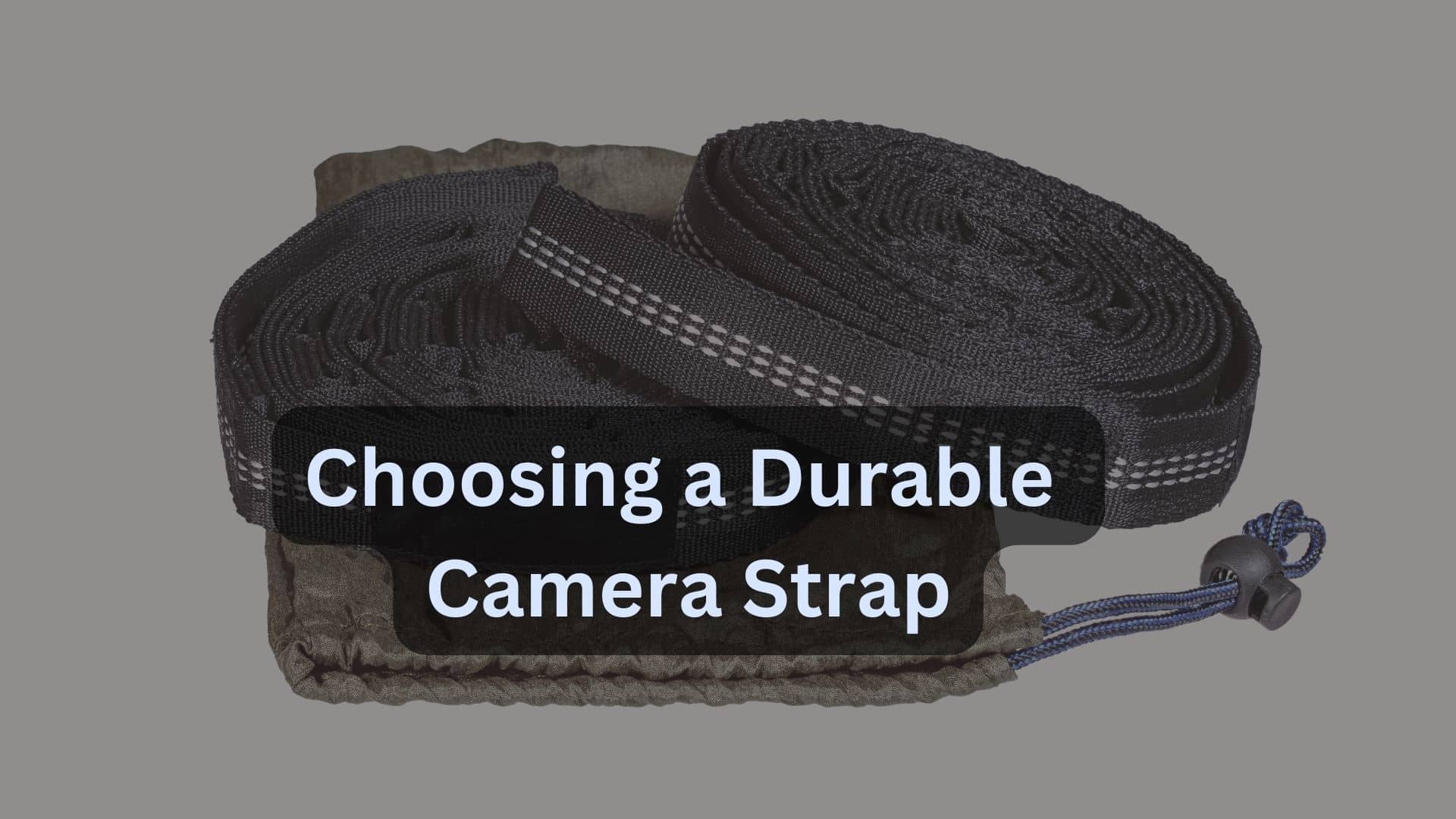Are you tired of uncomfortable and flimsy camera straps that leave you with aching shoulders and worry about your expensive equipment? Look no further! In this article, we will provide you with 5 essential tips on how to choose a camera strap that not only prioritizes your comfort but also ensures the durability of your precious gear.
With these tips in mind, you’ll be able to capture unforgettable moments without the burden of an uncomfortable camera strap weighing you down. So, let’s jump right in and discover how to find the perfect camera strap for you.
5 Tips for Choosing a Durable Camera Strap
When it comes to choosing a camera strap, comfort and durability are two key factors you should consider. After all, you’ll be relying on the strap to securely hold your camera while you capture precious moments. With so many options available in the market, it can be overwhelming to make a decision. But fear not, we’re here to help! Follow these 5 tips to find the perfect camera strap that combines both comfort and durability.
1. Consider the Material
The material of your camera strap plays a vital role in its comfort and durability. Here are three common materials to consider:
Nylon Straps
Nylon straps are popular due to their lightweight and durable nature. They are soft to the touch and often feature adjustable lengths, making them suitable for photographers of all heights. Nylon also has moisture-resistant properties, so you don’t have to worry about sweat or rain damaging your strap.
Leather Straps
If you prefer a more classic and stylish look, leather straps are an excellent option. Leather is known for its strength and durability, and it develops a beautiful patina over time. However, leather straps may be less breathable and can feel heavy, especially with heavier camera equipment.
Neoprene Straps
Neoprene straps offer excellent comfort due to their cushioning and padding. The material is soft and absorbs shocks, making it ideal for photographers who carry heavier gear or those who frequently move around. Neoprene also has moisture-resistant properties, ensuring your strap stays dry even during outdoor shoots.
2. Evaluate the Design
The design of a camera strap can greatly impact your comfort during a photo session. Consider the following aspects:
Width of the Strap
A wider strap provides greater weight distribution, reducing strain on your neck and shoulders. Look for straps that are at least 1.5 inches wide, as they provide better support and prevent discomfort during long shooting sessions.
Padding and Cushioning
If you often carry heavy camera equipment, opt for a strap with ample padding and cushioning. This helps to alleviate pressure points and increases overall comfort, especially when your camera is hanging for long periods.
Attachment Points
Ensure that the strap has sturdy attachment points that securely connect to your camera. Look for straps with metal connectors or reinforced stitching to avoid any accidents or mishaps while shooting.
3. Determine the Length
Choosing the right length for your camera strap is crucial for both comfort and convenience. Consider the following options:
Adjustable Length
An adjustable-length strap allows you to find the perfect fit for your body type and shooting style. This versatility allows you to wear the strap on your neck or across your body, providing different levels of comfort and accessibility.
Fixed Length
Fixed-length straps are typically shorter and more straightforward in design. They are ideal for photographers who prefer a specific length and don’t require the flexibility to adjust the strap on the go.
Cross-Body Design
A cross-body camera strap can offer added security and comfort, especially when you need quick access to your camera. It distributes the weight evenly across your body, reducing strain on your neck and shoulders.
4. Check for Durability
Durability is essential when choosing a camera strap, as it needs to withstand constant use and handling. Pay attention to the following factors:
Stitching and Seams
Inspect the stitching and seams of the strap thoroughly. Choose straps with reinforced stitching, as this ensures that the strap won’t unravel or come apart easily. Double stitching is a good indicator of durability.
Strength of Connectors
The connectors on the camera strap should be sturdy and capable of supporting the weight of your equipment. Look for metal connectors or high-quality plastic ones that are not prone to breakage.
Weight-Bearing Capacity
Consider the weight-bearing capacity of the strap. If you have a heavy camera or use additional accessories, ensure that the strap can handle the load without compromising your comfort or safety.

This image is property of images.pexels.com.
5. Consider the Comfort
Comfort is king when it comes to camera straps, as it directly affects your shooting experience. Take these comfort factors into account:
Weight Distribution
A well-designed camera strap should distribute the weight evenly across your body. Look for straps with broader and padded sections to prevent strain on your neck and shoulders.
Breathability and Moisture Resistance
If you often shoot in hot or humid environments, consider straps with breathable materials or moisture-wicking properties. This will help prevent discomfort from excessive sweat and ensure that the strap remains dry and comfortable.
Ergonomic Features
Some camera straps come with additional ergonomic features, such as contoured shoulder pads or adjustable straps. These features contribute to a more customized fit and enhanced overall comfort during long photography sessions.
6. Understand Different Types of Camera Straps
It’s important to be aware of the different types of camera straps available in the market. Each type has its own unique benefits and may cater to specific shooting styles. Here are three popular options:
Standard Straps
Standard straps are the most common type and often come bundled with cameras. They are simple, adjustable, and provide a reliable way to carry your camera around your neck or across your body.
Sling Straps
Sling straps are designed for photographers who require quick access to their camera. These straps hang diagonally across your body and allow you to swing the camera up to your eye level effortlessly. They are especially popular among event and street photographers.
Hand Straps
Hand straps are ideal for photographers who prefer a secure grip on their camera without the hassle of a neck or shoulder strap. They wrap around your hand, providing added stability and confidence when shooting. Hand straps are often used by photographers shooting on the go or handling large telephoto lenses.
Check Also: How to Capture a Stunning Bokeh Effect in Your Photos?
7. Research Customer Reviews and Recommendations
One of the best ways to gauge the comfort and durability of a camera strap is by researching customer reviews and recommendations. Here’s how you can gather valuable insights:
Check Online Forums and Communities
Visit photography forums or online communities where photographers discuss their equipment and experiences. Look for threads or discussions specifically about camera straps to learn from the experiences of other photographers.
Read Product Reviews
Read product reviews on reputable websites to gather feedback from users who have purchased and used the camera straps you’re interested in. Pay attention to their comments about comfort and durability to make an informed decision.
Seek Recommendations from Photographers
Reach out to photographers in your network or social media platforms and ask for their recommendations. Experienced photographers can provide valuable insights based on their personal experiences and preferences.
8. Consider Your Specific Needs and Preferences
Ultimately, choosing a camera strap should be based on your specific needs and preferences. Take the following factors into consideration:
Type of Photography
Consider the type of photography you primarily engage in. If you shoot landscapes or portraits, a standard strap may be sufficient. However, if you frequently move around or work in challenging environments, a sling strap or hand strap may be more suitable.
Camera Weight and Size
The weight and size of your camera and lenses will impact your comfort when using a camera strap. Heavier equipment may require a strap with extra cushioning and wider support to distribute the weight effectively.
Personal Style and Aesthetics
Don’t forget to factor in your personal style and aesthetic preferences. Camera straps come in a wide variety of designs, colors, and patterns, allowing you to showcase your personality while photographing.
Source: TheTechBrain Ai
9. Set a Budget
Setting a budget is an important step in finding the ideal camera strap. Consider the following aspects:
Decide on a Price Range
Determine how much you are willing to spend on a camera strap. Setting a budget helps narrow down your options and prevents you from overspending.
Compare Prices and Features
Once you’ve determined your price range, compare prices and features of different camera straps within that range. Look for straps that offer the best combination of comfort, durability, and value for money.
Opt for Value for Money
While it’s tempting to go for the cheapest option, remember that durability and comfort are crucial factors. Aim for a camera strap that offers good quality and fits your requirements rather than prioritizing price alone.
FAQ
What are the most comfortable camera strap materials?
Nylon and neoprene are known for their comfort due to their softness and padding. These materials provide cushioning and distribute weight effectively, offering a comfortable shooting experience.
How do I choose the right length for a camera strap?
The right length for a camera strap depends on your shooting style and preference. Adjustable-length straps offer versatility and allow you to find the perfect fit, while fixed-length straps are more suitable for photographers who prefer a specific length.
Are sling straps suitable for all types of photography?
While sling straps are popular among many photographers, they may not be suitable for all types of photography. They are particularly favored by event and street photographers who require quick and easy access to their camera. Consider your shooting style and needs before opting for a sling strap.
Conclusion
Choosing a camera strap that provides both comfort and durability requires careful consideration of materials, design, length, durability, comfort, and your specific needs. By evaluating these factors and researching customer reviews, you can make an informed decision that will enhance your photography experience. Remember, a comfortable and durable camera strap is an investment in your passion for capturing amazing moments. Happy shooting!



